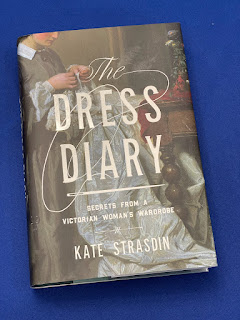Book Review: The Dress Diary by Kate Strasdin
I've been waiting for this book to come out ever since I learned about it from an interview with the author on the Dress: Fancy podcast.
Basically, the author was given an old scrapbook of textile swatches, kept and collected by a random ordinary merchant-class British woman throughout her life, that was ultimately found in a stall in Camden Market. I suppose it's actually a book about material culture and what this artifact of a 19th century life can illuminate and obfuscate.
I gather from the introduction that these books were perhaps not as commonly kept as a written diary but were at least enough of a phenomenon that other clothing textile scrapbooks exist in the collections of other museums. It's wild to think that even if these things were frequently assembled by lots and lots of women, they would have probably been something discarded into the trash by heirs after the deaths of their makers, as not worth keeping. And yet it's clear from this book analyzing the contents of just one extant swatch diary, they indicate so much about the lives of people otherwise invisible in the history as recorded by Western colonialism.
Author Kate Strasdin uses the artifact of the dress diary to explore numerous aspects of the 19th century textile industry, from the Lancashine cotton mills so closely intertwined with Anne's family to the travesty of the global cotton trade built on the backs of the enslaved. She explores innovations in textile weaving, manufacturing, and printing, as well as the artisanal trades such technologies made obsolete. She traces the path of lacemaking from the delicate cottage industry of bobbin lace to the mechanization of machine-lace.
Chapters on early 19th-century dressmakers, tailors and milliners in Anne Sykes' orbit make it clear that garment workers have always been (and continue to be) highly skilled, overworked, underpaid, and mistreated by both their clients and employers. The circumstances are different but I found myself continually reminded of garment-workers' struggles that would arise in the intervening time, from the Triangle Shirtwaist Factory fire to the 21st-century injustices in the sweatshops of Indonesia and Bangladesh.
There's a chapter on Victorian mourning customs (as there are several swatches in the diary captioned for the mourning attire of various people Anne Sykes knew), with fascinating information about how the sartorial expectations of "proper" mourning were codified, marketed, and observed by people at varying levels depending on gender, class, geographic location, etc.
There's also a chapter on fancy-dress balls and Victorian masquerade costume, because there's a swatch from a Dolly Varden costume (according to its caption) that her friend wore to a costume party just after Dickens' Barnaby Rudge came out, when the character of Dolly Varden would have been popularly known. And the author even makes the comparison to contemporary cosplay culture in that section! So fascinating.
A whole chapter focuses on a single, singular swatch from the dress of the Sykes' longtime cook, Margaret Charnock. Strasdin discusses the servant class and the rarity of surviving examples of their clothing, due to the physical labor of their work exacting wear and tear on the garments and the economy of the people who wore them reusing the textiles many times over, most ending in being cut up for rags or wadding. This fabric scrap in Anne's dress diary is an exceptionally rare glimpse into one garment belonging to one working class woman nearly two centuries ago.
As a safety representative and dyeroom supervisor, the chapter I found most engrossing concerns the way the development of aniline dyes in the middle of the 19th century is reflected among the colors of the textile swatches in the artifact. The author explores the intersection between the textile industry, fashion trends, and the developing science of chemistry. and the related topics of sustainability and safe work practices. The touchstone swatches for all of these topics belonged to a flamboyant middle-aged acquaintance, the aptly-named Bridgetanne Peacock, who appears through several years worth of the collection.
This book first came out in the UK under the title of The Dress Diary of Anne Sykes, and was released to the US as The Dress Diary: Stories from a Victorian Woman's Wardrobe. It includes sixteen full-color pages as an insert in the middle of the book, photo reproductions of pages/swatches in the original artifact.
A QR code at the end of the book leads to this webpage containing full-color scans of 16 more pages of textile swatches including some mysteries, people the author was unable to uncover in the historical record at the time of the book's printing.
I wholeheartedly recommend this book to fashion historians, garment makers, sewing history enthusiasts, Mancunians/Liverpudlians and other residents of the north of England, material culture scholars, those researching the history of textiles and the globalization of fashion, and anyone for whom any part of this narrative piques an interest. Well-researched and utterly absorbing.



Comments
Post a Comment